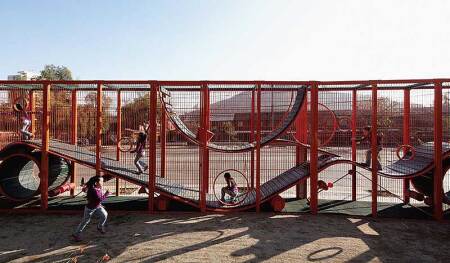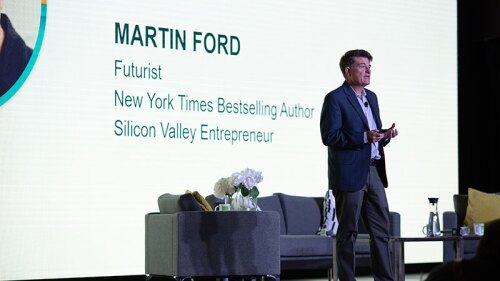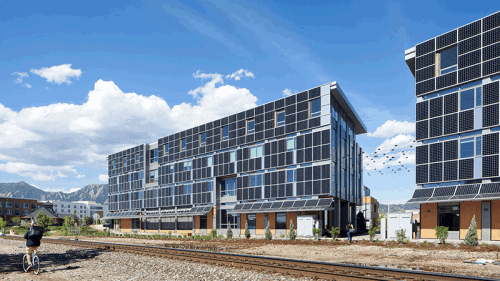Internationally acclaimed architect Alejandro Aravena, whose rise to prominence stemmed from his ability to synthesize design challenges to provide solutions that channel people’s capacity to create vibrant communities, has been named the 2019 recipient of the ULI J.C. Nichols Prize for Visionaries in Urban Development.
The ULI J.C. Nichols Prize honors the legacy of Kansas City, Missouri, developer J.C. Nichols, a founding ULI member considered one of America’s most creative entrepreneurs in land use during the first half of the 20th century. Aravena, a lifelong resident of Chile, is the first Latin American to be awarded the prize, which recognizes an individual who has made a distinguished contribution to community building globally, who has established visionary standards of excellence in the land use and development field, and whose commitment to creating the highest-quality built environment has led to the betterment of society. He was honored as the 20th Nichols laureate and was a featured speaker at ULI’s 2019 Fall Meeting in Washington, D.C.
Aravena, who was awarded the Pritzker Architecture Prize in 2016, is the founder of Elemental, a Santiago-based architecture firm at which he is a partner with Gonzalo Arteaga, Juan Cerda, Victor Oddó, and Diego Torres.
Elemental, which he refers to as a “do tank” (rather than a think tank), has designed extraordinary buildings and places around the world, including several environmentally innovative spaces at Universidad Católica de Chile; flexible office space in Shanghai; dormitory space at St. Edward’s University in Austin, Texas; the Jan Michalski Foundation’s writers residences in Montricher, Switzerland; the Art Mill cultural center in Doha, Qatar; and a new development at the Energias de Portugal headquarters site in Lisbon.
Aravena and Elemental are equally renowned for projects of public interest and social impact, including affordable housing, public space, infrastructure, and transportation. Through this work, Aravena and his Elemental partners focus on overcoming limited resources with synthesized designs that address major urban challenges affecting people’s quality of life.
One example of this approach is the incremental housing designed by Elemental for residents of the Chilean city of Constitución following a devastating earthquake and tsunami in 2010. Incremental housing involves providing the basic structure of the dwelling (which Aravena refers to as “half of a good house, instead of a small one”), leaving the remainder to be completed by residents, allowing them to customize their homes and instilling in residents a sense of pride and accomplishment.
This approach, which proved highly successful in Constitución, was deemed by Elemental to be the most cost-efficient way to quickly house thousands of people in need of a place to live. While it was a response for residents displaced by a catastrophe, it is an approach Aravena believes could be replicated to increase the supply of affordable housing in other cities.
Selection of Aravena as the Nichols laureate “continues a tradition of citing people who have big, bold ideas,” says Michael Spies, Nichols Prize jury chairman, ULI trustee, and senior managing director of Tishman Speyer in New York City.
“His approach to architecture is one of really wanting to understand who will be using a space or affected by a space, and how the space will fit within the constellation of activities around it,” Spies says. “From the start of a project, he focuses on absorbing all the dynamics, circumstances, and challenges that could be affected by that physical form so its impact will be as broadly beneficial as possible.”
Elemental’s holistic approach is one that was advocated by J.C. Nichols, who wrote in 1919, “An intelligent city plan thinks impartially for all parts of the city at the same time and does not forget the greater needs of tomorrow in the press of today. It is simply good, practical, hard sense.” This statement still holds true 100 years later, says Aravena, noting that every aspect of his work—and his belief in the resourcefulness of people to help solve urban challenges—is about using common sense.
“Too often in the built environment, what dominates is the commonplace. Let’s exchange the commonplace for common sense,” Aravena says. “If we are rigorous and bold in pursuing that, we may have a chance to intelligently plan the built environment for the generations to come.”
In addition to Spies, jury members were ULI trustees A. Eugene Kohn, founder and chairman of Kohn Pedersen Fox, New York City; Jodie W. McLean, chief executive officer of EDENS, Washington, D.C.; and Leslie Woo, chief development officer of Metrolinx, Toronto; as well as Maurice Cox, director of the City of Detroit Department of Planning and Development.
“The main contribution architecture makes to the built environment is what it inspires in human behavior,” McLean says. “One of Alejandro’s greatest accomplishments is the process in which he’s connected architecture and working with communities, taking care to include people’s ideas on how to make a better environment to improve all parts of the community. He doesn’t just draw solutions; he strives [for his work] to be part of the solution.”
Aravena was director of the Venice Architecture Biennale 2016, and a speaker at the TEDGlobal conference in Rio de Janeiro in 2014. In 2010, Aravena was named an International Fellow by the Royal Institute of British Architects, and he was named one of the 20 “new heroes of the world” that year by Monocle magazine. In addition, he is a board member of the LSE Cities program at the London School of Economics, a regional advisory board member of the David Rockefeller Center for Latin American Studies, a board member of the Swiss Holcim Foundation, and a founding member of the Chilean Public Policies Society.
In a recent interview with Urban Land, Aravena reflected on the power of architecture to improve people’s quality of life, and the necessity of taking design risks to provide the most effective solutions.
What drew you to architecture as a way not just to improve the cityscape, but improve people’s lives?
I graduated from Universidad Católica de Chile in 1992, and for eight years I was practicing in a rather conventional way. Then in 2000, I was invited to teach at Harvard, and it was there that I discovered I had been considering the wrong questions [in terms of how to influence people’s lives through architecture]. So I switched my focus to broader questions of interest to the community in general, and to addressing those questions with my knowledge of architecture. I asked myself, can I contribute with my specific knowledge to nonspecific issues like poverty, resentment, anger, violence, insecurity? When you change the questions you are addressing, you have to adapt your answers and use your training for something different than what you were doing so far.
At Harvard, I was competing for students with Rem Koolhaas, Jacques Herzog, Pierre de Meuron, and other well-known architects, and I thought, what can I say in this context that others are not talking about? And scarcity of means was something I did know about. In Chile, you are working with so little resources and with people outside the developed world. So I decided to focus on that issue [maximizing the impact of designs created with minimal resources].
You have often talked about the power of synthesis to overcome seemingly insurmountable problems. Why do you believe so firmly in this approach?
The more complex the question, the more the need for synthesis. The challenge is to keep the original complexity, all the dimensions, but provide an answer that is simple and synthetic. I believe that when you create a design proposal, you should factor in all the dimensions at once, and what you are designing addresses all the forces—economic, political, social, environmental—that inform a building or a place. You have to establish priorities, but all the dimensions are present in the proposal.
You have said that if something is unique, it can’t be repeated, and as a result, its value is limited. Please tell us more about this.
Sometimes there is a case to be made for uniqueness, such as when a community is waiting for a symbol, a gesture, that touches the people’s imagination. In those circumstances, our role is to deliver products that are finished, that are unique. Other times, our role is to trigger an ongoing process that evolves through a life of its own, and that is the value of what is delivered. The challenge is to understand when each approach is appropriate. In some cases, if you do something that cannot be replicated, then you are not understanding the real question behind the challenge. It’s a matter of knowing what solution best addresses the situation, and that solution may be a process that is replicable and adaptable.
You have also said that architects are authors, not consultants, and as a result, they should take risks with their proposals and be willing to reject the status quo. Could you elaborate?
A consultant gathers information and understands the forces at play and the constraints, but the responsibility for deciding what to do is with the party who hired the consultant. As an architect, you gather information and understand the forces of constraint, but you then take a risk with a proposal for what needs to be done. That is the difference between a consultant and an author. Reason and rationality are part of the proposal, but intuition plays the biggest role in synthesizing a challenge into a usable solution for the client. The equation that informs a project is compelled by concrete factors such as deadlines, budget, and regulations, but sometimes there is fear or skepticism, and those things belong in the equation along with expectations. It’s very important to use intuition to integrate all those forces into the equation. If you do that right, you can see the energy in the room change, because all the forces affecting a project have been recognized.
When we [at Elemental] decided to work in social housing, we risked our reputation to do it. But despite the risk of failing, the community [disaster-ravaged Constitución] was so desperate for a solution that the potential for common good was high. We said, “It makes sense. Let’s go for it.” And we had to learn to live with the “good enough.” Maybe a great project would be fantastic, but in order to go from paper to reality, sometimes you have to live with the good enough so it gets done. Good enough is better than nothing.
Affordable housing is a challenge for cities around the globe. Elemental’s incremental housing approach in Chile is an intriguing solution. What sparked this idea, and do you think it could be replicated in other places?
We are living in the era of cities. They are magnets for people, resources, ideas, and money. The problem is the three “s” menace—scale, speed, and scarcity of means—that challenges our ability to accommodate all the people coming to cities. By 2030, there will be 5 billion people living in cities worldwide, 2 billion of whom will be living in poverty. This means that housing needs to be built for 1 million people per week using only $10,000 per family [an average amount based on the housing budgets of developed and developing countries]. This was the starting point for our social housing projects. And, at the time, the amount per family in Chile was even less: it was $7,500 per family, with which we had to buy land, provide infrastructure, and build a house. So, we focused on what we could do that would affect the most people and what we could do that families cannot do on their own.
We decided to address scarcity of means with “incrementality”—by doing what is most strategic and then allowing the families to complete their homes over time. Through this incremental approach, we have added people’s own resources to what is provided by markets and governments. And, incrementality allows for a more custom-made solution than what is possible using a more centralized approach. It also became apparent that families develop a sense of pride in completing their own houses. We provide the structure, and then families begin to add, some for the first time in their lives, an expression of themselves. And that leads to taking care of the home over time, keeping it beautiful over time, and maintaining the common spaces. We have used the problem of scarcity to provide a solution to monotony and a way to achieve economies of scale. With incremental housing, we have introduced a new form that becomes a process of urban space customization.
The first Nichols laureate was former Charleston, South Carolina, mayor Joseph Riley. He talked about the importance of making cities great places for all residents so they would feel a sense of pride and belonging. How do you apply this philosophy in your work?
I could not agree more. In more and more cities, wealth and quality of life are concentrated among a few, and this is what causes conflicts. Inequality is a daily experience in cities. It’s what you experience when you live in a neighborhood with no opportunities, and then you commute to the parts of the city where everything is better—public space, transportation, buildings, and access to jobs, health care, and education. And then you go home to where none of those things are part of your everyday experience. It comes down to “Why them and not me?”
Cities can actually provide a shortcut to equality by improving the quality of life for all residents through what is available for free. Great public space is a powerful equalizer in that everyone can enjoy the best parks, river shores, or promenades. For people who cannot afford to take holidays, imagine how it feels to be able to spend time in the nicest, greenest area of a city. Access to high-quality public space can help counterbalance what you cannot afford because you don’t have the best education or the best job.
Of all your work, is there one project that best exemplifies your belief in the power of architecture to shape people’s lives?
That is like choosing among your children: you can’t prefer one over the other. I would say we have been applying the same concept over and over, just in different ways with different projects. Our entire body of work is based on overcoming scarcity of means and time by using design to channel people’s own capacities. We have learned to respond with what is absolutely essential, to take out the superfluous, yet provide a response that considers not just people’s needs, but also their desires [to make places their own].
With social housing, it was only a few weeks before what we had built started becoming middle-class housing. That happened not because of us, nor the state, nor the markets, but because of the families themselves. This has happened over and over. And we are applying what we have learned to a discussion with the minister of housing [in Chile] on how to develop an emergency typology to accommodate refugees. The name of our firm, Elemental, means something that cannot be further reduced. By being forced by scarcity to concentrate on what is irreducible, we are opening the potential of the concept [channeling people’s capacities for design customization] being valid in many circumstances, in many places.
ULI has more than 45,000 members around the globe representing all aspects of the industry. What advice do you have for our members?
In the built environment, one of the biggest challenges is that we [industry professionals] tend to be very conservative in terms of willingness to be the first to do something. The incentives tend to benefit the second movers. That is why we do not innovate and instead continue to respond to new questions with old answers. If you identify a new need or a new challenge and you succeed with a new solution, others will copy you. City building is not like other industries, where you can patent your ideas, so everyone waits for the someone to make the first move so they can copy the idea if it works.
At Elemental, we believe there is a need to fight the cliché and to move first. And instead of obtaining copyrights for our designs, we have “copy lefts,” which means that from our website, you can download designs for free—take them, use them. So, my message would be this: all of us who are working in the built environment should make the first move that changes a situation. Fight the cliché, step out of the herd, and be bold.







